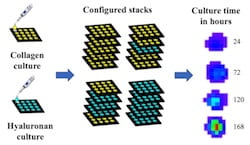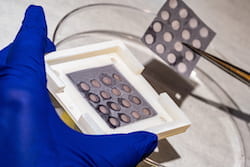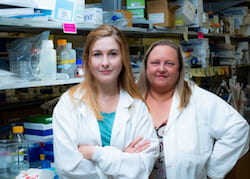NEWS RELEASE
Mike Williams
713-348-6728
mikewilliams@rice.edu
Paper trail leads to heart valve discoveries
Rice University bioengineers’ filter-paper models hint at how valves calcify
HOUSTON – (Aug. 5, 2019) – Paper is at the heart of an experimental device developed by Rice University bioengineers to study heart disease.
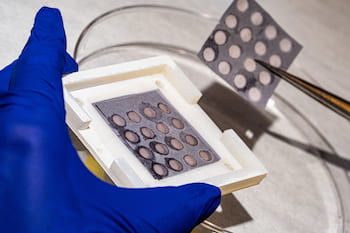
Rice researchers are configuring layered filter paper to mimic aortic heart valves. Photo by Jeff Fitlow
They are using paper-based structures that mimic the layered nature of aortic valves, the tough, flexible tissues that keep blood flowing through the heart in one direction only. The devices allow the engineers to study in detail how calcifying diseases slow or stop hearts from functioning.
The work by the Brown School of Engineering team, detailed in Acta Biomaterialia, shows that collagen 1, a natural protein and a component of the valves’ fibrous extracellular matrix, appears to have a strong association with calcification when it is found outside its usual domain. Valves hardened by calcium deposits are less flexible and lose their ability to seal the heart’s chambers.
“When tissues make a lot of excess type 1 collagen, it’s called fibrosis,” said Rice bioengineer Jane Grande-Allen, who directed the study with Rice graduate student and lead author Madeline Monroe.”Fibrosis can happen in many types of tissues and it accompanies calcific aortic valve disease (CAVD). That doesn’t necessarily mean collagen will always cause CAVD, but it definitely drove the calcification-linked phenotype in the cells that we cultured.”
Collagen generally stays in the valve’s fibrosa layer, one of three in each of the three leaflets that make up an aortic valve. (The others layers are the spongiosa and ventricularis.) The researchers prepared paper layers to support heart valve cells embedded in either collagen or hyaluronan, and discovered that when collagen 1 proteins are present in multiple layers, the cells behave in a way that would ultimately lead to mineralized lesions.
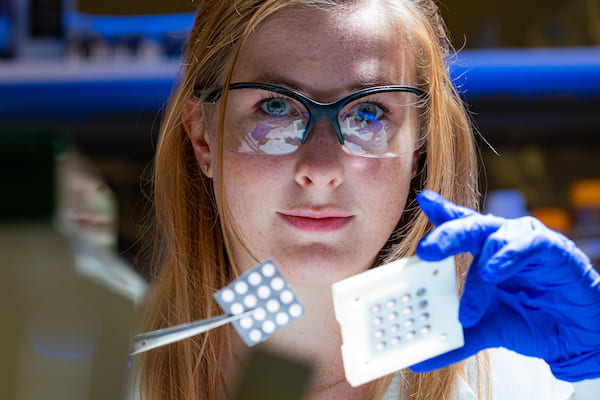
Rice graduate student Madeline Monroe led a project to use layered filter paper to mimic aortic heart valves. Photo by Jeff Fitlow
Grande-Allen said the layers of extracellular matrix in a healthy aortic valve are well-defined. “In a more pathological state, the collagen isn’t localized,” she said. “It’s spread out. Our models suggest nonlocalized collagen could contribute to cell overexpression of these calcific factors.”
The Rice researchers want to know how that happens. They needed a way to see how valve cells would react to collagen spreading through a three-dimensional tissue, and common filter paper turned out to be a suitable stand-in. What they made doesn’t look like a heart valve, but effectively acts like one to show how cells proliferate through a valve’s layers.
Heart valve disease can’t be treated with a pill yet, said Grande-Allen, who has studied valve disease for much of her career and reported on paper-based cultures in 2015. Current remedies often involve replacement of the valve with human or animal donor tissue or a mechanical valve. But the ability to accurately model and manipulate all the layers of a valve could help decipher the chemical transactions in heart disease. She said that may eventually lead to noninvasive medication.
“The first step has been to develop models that mimic the way the cells in valves behave,” Grande-Allen said. “The next step would be to see them actually calcify. Once that is in hand, we can start to test chemicals that would block that calcification process.”

Rice bioengineers stacked paper filters to culture heart valve cells in collagen and hyaluronan, both natural hydrogels, to see how they influenced calcification of the model. Illustration by Madeline Monroe
Monroe, with co-author and Rice undergraduate Rebecca Nikonowicz and early help from alumnus Matthew Sapp, took inspiration from the cells-in-gels-in-wells filter-paper cultures used at Harvard University to study hypoxia in lung cancer cells.
The Rice lab started by 3D-printing polymer holders with arrays of holes. These held in place layers of paper that had been impregnated with a wax pattern to eliminate crosstalk between the open circles of filter paper. The circles were then saturated with various combinations of fibrous collagen 1, hyaluronan (normally found in the spongiosa layer) and millions of living heart cells, and the sheets were pressed together within the holders.
“This modeling system gives us complete control over a lot of different variables,” Monroe said. “We were able to create distinct stacks with different compositions based on what components we put in each layer. We had stacks where all the layers were all hyaluronan, or all collagen, or heterogeneous stacks with both kinds of layers.
“That let us see if the cells behaved differently when there was an increase in the number of collagen layers,” she said.
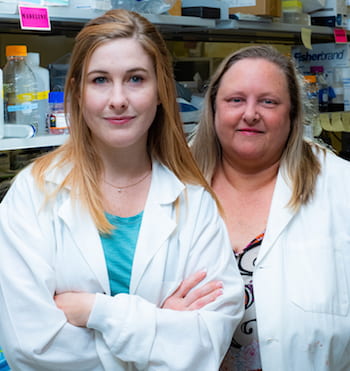
Rice graduate student Madeline Monroe, left, and bioengineer Jane Grande-Allen led a project to use layered filter paper to mimic aortic heart valves. The technique revealed that a natural collagen appears to have a strong association with calcification when it is found outside its usual domain. Photo by Jeff Fitlow
Monroe assessed the cells’ behavior over time by analyzing the protein markers they expressed, particularly alpha smooth muscle actin (aSMA), a Runt-related transcription factor-2 (RunX2) and SRY-box 9 (Sox9), all of which are indicators for CAVD. Using a high-throughput staining and scanning method with the groups of wells allowed her to quickly gather data from dozens of structures.
The data let them see that valvular interstitial cells, the principal and normally stable aortic valve cell type, became more susceptible to osteogenesis — hardening — in the presence of more layers containing collagen protein.
“The paper model is ingenious for allowing us that versatility and flexibility,” Grande-Allen said. “I don’t know of another method that so easily allows us to put together different layers easily, culture the combinations together and then take them apart and analyze them so rapidly.”
Grande-Allen is Rice’s Isabel C. Cameron Professor of Bioengineering and chair of the university’s Department of Bioengineering. The National Science Foundation and the American Heart Association supported the research.
-30-
Read the abstract at https://www.sciencedirect.com/science/article/pii/S1742706119305355?via%3Dihub.
Follow Rice News and Media Relations on Twitter @RiceUNews.
RELATED LINKS:
Heart valves strive to get oxygen one way or another: http://news.rice.edu/2016/12/20/heart-valves-strive-to-get-oxygen-one-way-or-another/
Study probes heart of synthetic heart valves: http://news.rice.edu/2016/05/11/study-probes-heart-of-synthetic-heart-valves/
High blood-sugar levels may harden heart valves: http://news.rice.edu/2014/10/20/high-blood-sugar-levels-may-harden-heart-valves-2/
Clotting protein hardens aging hearts: http://news.rice.edu/2013/11/07/clotting-protein-hardens-aging-hearts-2/
Integrative Matrix Mechanics Laboratory: http://grandegroup.blogs.rice.edu
Rice Department of Bioengineering: https://bioengineering.rice.edu
George R. Brown School of Engineering: https://engineering.rice.edu
IMAGES FOR DOWNLOAD:
https://news2.rice.edu/files/2019/08/0805_PAPER-1-WEB.jpeg
Rice University bioengineers stacked paper filters to culture heart valve cells in collagen and hyaluronan, both natural hydrogels, to see how they influenced calcification of the model. (Credit: Madeline Monroe/Rice University)
https://news2.rice.edu/files/2019/08/0805_PAPER-2-WEB-1.jpg
Rice University graduate student Madeline Monroe led a project to use layered filter paper to mimic aortic heart valves. The technique allows researchers to study in detail how calcifying diseases slow or stop hearts from functioning. (Credit: Jeff Fitlow/Rice University)
https://news2.rice.edu/files/2019/08/0805_PAPER-3-WEB.jpg
Rice University researchers are configuring layered filter paper to mimic aortic heart valves. The technique allows researchers to study in detail how calcifying diseases slow or stop hearts from functioning. (Credit: Jeff Fitlow/Rice University)
https://news2.rice.edu/files/2019/08/0805_PAPER-4-WEB.jpg
Rice University graduate student Madeline Monroe, left, and bioengineer Jane Grande-Allen led a project to use layered filter paper to mimic aortic heart valves. The technique revealed that a natural collagen appears to have a strong association with calcification when it is found outside its usual domain. (Credit: Jeff Fitlow/Rice University)
Located on a 300-acre forested campus in Houston, Rice University is consistently ranked among the nation’s top 20 universities by U.S. News & World Report. Rice has highly respected schools of Architecture, Business, Continuing Studies, Engineering, Humanities, Music, Natural Sciences and Social Sciences and is home to the Baker Institute for Public Policy. With 3,962 undergraduates and 3,027 graduate students, Rice’s undergraduate student-to-faculty ratio is just under 6-to-1. Its residential college system builds close-knit communities and lifelong friendships, just one reason why Rice is ranked No. 1 for lots of race/class interaction and No. 2 for quality of life by the Princeton Review. Rice is also rated as a best value among private universities by Kiplinger’s Personal Finance.
